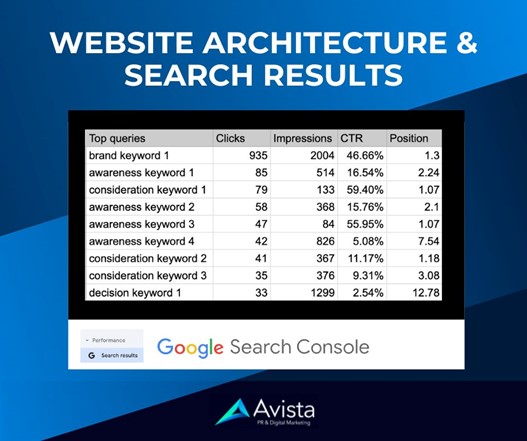by Team Avista
Share
by Team Avista
Share

Search engine algorithms are constantly evolving. In 2022, Google launched a total of 4,725 changes to search; that means the search algorithm and index average 13 daily changes.
While it’s challenging to keep up with and manage these changes, it’s worth the effort. B2B SEO campaigns generate conversions with a much lower cost-per-lead than other channels and strategies. According to a study published on Statista.com, “the average cost per lead (CPL) in the business-to-business software-as-a-service (B2B SaaS) industry in the United States amounted to 310 U.S. dollars for paid channels. For organic ones, the CPL reached almost 165 dollars.”
Avista PR & Digital Marketing uses these six pillars in every SEO campaign to keep the traffic graphs moving in the right direction. Don’t get distracted by an SEO audit with thousands of items on the list; start with these six items, and you’ll have a solid foundation for growth.
1. Prioritize Technical SEO Issues
The crawling and indexing reports in Google Search Console can be overwhelming, but ignoring these priority items will sabotage your best SEO and content marketing efforts.
Log into your Google Search Console account and start with the Page Indexing Report. Prioritize these items:
- Review and fix 4xx errors
- Review index & blocked by robots.txt, review with the development team
- 500-level errors. Review URL structure and fix redirect loops and chains.
Is your team uncomfortable directing developers on technical SEO items? We can help.
2. Website Architecture
SEO guidelines are constantly changing, but don’t assume that older guides don’t apply. Google’s developer guides on search indexing and website crawlability are still relevant and deliver ranking results.
“Organize your website in a way that allows your users (and search engine robots) to get easy access to your content.” –Search Engine Journal.
Setting up the right website architecture will help you organize content according to audience and funnel stage.
3. Content for the Right Audience: Buyer Intent

Image source: https://www.gartner.com/en/digital-markets/insights/demand-generation
Aligning topics with your target audience’s questions, pain points, or industry concepts with the marketing funnel and website architecture will improve website rankings and conversion rates. Educational content (awareness stage) is very important for improving website traffic, but it won’t move the needle on conversions potential clients can’t find your content during the consideration and decision stages.
Not sure which words and phrases are the best match for each stage of the funnel? Get feedback from sales and management teams; they talk with leads every day. They’ll provide valuable insight on common questions and phrases used during each stage of the sales funnel.
4. Minimum Search Volume & High-Value Pages
Review the topics and keywords associated with your website’s main navigation pages. Do those phrases have a search volume greater than 100 searches per month? If not, it’s time to consider using related keywords that meet minimum search volume standards. If possible, target phrases with lower competition.
An Ahrefs study reports that the majority of pages in Google’s index get ZERO organic search traffic (approximately 96% of pages). If your website pages are targeting phrases and keywords that don’t have any demand (or search volume), they won’t get traffic.
Companies invest a lot of time and effort in SEO for blog posts, case studies, and industry news, but getting traffic to a main service or product page gives lead generation a significant boost. Not sure which keywords or phrases to target? Start with competitor research; which words and phrases are competitors using? Plug all of those words and phrases into a keyword research tool, Export the metrics, and review the low-competition terms with your leadership and sales team. Get feedback from other departments and make sure the terms match ‘buyer intent’ for the best results.
Here’s a sample keyword export with a legend to highlight keywords according to the competition:

5. User Experience Design (UX)
Websites that drive traffic but fall flat for conversions don’t generate leads and fall flat on reaching sales goals.
A stress-free user experience is the key to turning an interested party into your next customer. Heatmap tools like HotJar report that lead-generation efforts skyrocket once the obstacles in the online buyer journey are eliminated. UX Design focuses on the user needs, pain points, and journey, providing products and services that solve the customer’s unmet needs and desires and create a frictionless path toward calls-to-action.
6. Video Optimization
Statistics show that adding video to your demand generation campaign’s repertoire will increase its success. Most brands have lots of video content, but Google can’t find it because it’s not optimized for search engines.
Send your development team a link to Google’s Search Central Video SEO Guide. If you have trouble getting buy-in from leadership, share these statistics with them:
- 66% of viewers will watch a business-related video to the end if it’s under 60 seconds. (Vidyard, 2023)
- 84% of consumers said watching a brand’s video convinced them to purchase or subscribe to a service. (HubSpot, 2022)
- 78% of businesses say they received more traffic after implementing videos in their content strategies. (SerpWatch, 2022)
- Video simplifies the decision-making process for complex buying cycles and large management teams (SearchEngineLand, 2024)
Proceed with Caution
If you’re bringing an SEO marketer in-house or you’re outsourcing SEO services, ask them to check the Search Results report in Google Search Console. The report will give them a list of phrases and keywords that are driving impressions and clicks from the first few pages of the search results, and it will give you insight into which pages are driving the most value for new and returning users..
Here’s a sample report that identifies keywords according to their stage in the marketing funnel. Note the ‘Decision Stage’ keyword – it doesn’t show up on page one, reducing the overall number of impressions and clicks:

With these six SEO pillars in place, your demand-generation campaigns will improve company visibility, lead generation, customer acquisition and sales, just like it did for Forty8Fifty Labs when Avista performed a keyword ranking analysis and applied it to their website refresh. If you are ready to launch or improve a winning B2B SEO campaign, the Avista team can help.
Related Posts:
SEO Content Best Practices That Improve Organic Traffic & Rankings
STAY IN THE LOOP





